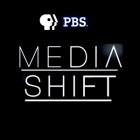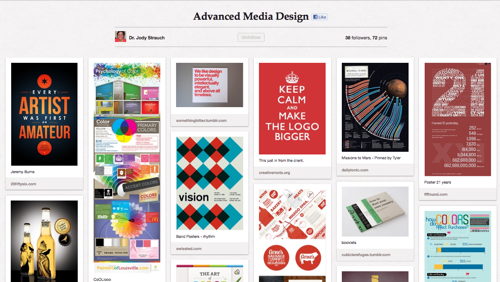Aggregating images to share with students is an increasingly common classroom use for the tool.
Jody Strauch at Northwest Missouri State University has used Pinterest to show good design work to her media design classes. Heather Starr Fielder uses Pinterest boards in her classes at Pittsburgh's Point Park University to share visual material for collaborations and peer critiques.
And Robert Quigley at the University of Texas in Austin showed students what ad agency GSD&M did with its South by Southwest "survival board." (He also wrote up a tips piece for news users on Pinterest and now plans to have students create a Pinterest channel for a new social media-only news agency for college students that he has in the works.)
But social curation journalism is, not surprisingly, one of the main applications for Pinterest among J-school faculty. For example, Carrie Brown-Smith, a journalism prof at University of Memphis, had students use Pinterest as part of a "social photography" assignment in a media site. She said the best Pinterest work came from students who have beats or blog topics, such as fashion, that are well-suited to Pinterest's strengths.
Similarly, at Colorado State University, Michael Humphrey found students with an interest in lifestyle and arts, such as architecture, food or fashion, tended to lean toward Pinterest when given the choice with Tumblr or Posterous for a digital media aggregation assignment.
At Minnesota State University Moorhead, Deneen Gilmour assigned students in a "writing for the web" class to produce stories for their Doing It Downtown blog to use Pinterest as a curation tool for visuals, while using Storify for social media and Spotify or LastFM for music. One student produced an innovative story with the Pinterest boards she gathered to help guide restaurant and shop-goers to gluten-free menus items.
Cindy Royal at Texas State, who is looking into integrating the tool into her digital/online media course, had new media students create a series of boards to guide visitors to South by Southwest. (Other news organizations used Pinterest for their South by Southwest coverage as well.)
And Kelly Fincham, who teaches journalism at Hofstra University, came up with a clever formula for asking students to create their own Pinterest boards. "I teach Pinterest as a visual 'SPACE,'" she wrote on the ONA Educator's Facebook group. "S is for sourcing story ideas and trending topics; P is for promotion and publishing students' work. A is for aggregation of pictures (with suitable copyright); C is for curating top news, and E is for engaging with others."
WHAT ABOUT COPYRIGHT?
Pinterest is not without its drawbacks. Not all students, especially males, find it equally intriguing. USC's Lih noted that while the site was a plus for his USC project, most students discontinued use after the class. One additional problem, he said, is that Pinterest doesn't allow users to pin background images or those that are part of a CSS stylesheet, preventing pins for embedded logos or banners.
But the big issue some are warning about with Pinterest has to do with its copyright policy regarding the images users pin.
Lawyer and amateur photographer Kirsten Kowalski likened it to Napster due to the liability its terms of service and copyright policies create for users of the site; she then "tearfully" deleted all her boards. Another attorney writing in Ad Age last week advised brand managers to strictly limit what they pin.
In the wake of the buzz over Kowalski's posts, Pinterest's management has tried to respond to copyright worries. The Washington Post reported that Pinterest issued a statement on March 15 suggesting that, like YouTube and other social media sharing sites, it is "protected under the safe harbor of the Digital Millennium Copyright Act (PDF)," and also tries to respond promptly to any copyright violation concerns.
But blogger Christopher Mims of Technology Review suggested last month that Pinterest's "copyright dodge" is actually a stratagem that has helped fuel the site's growth. Rather than force users to figure out copyright first before posting an image, a la Flickr, it simply provides a flagging mechanism for copyright violation after posting. "By resolving the rights on an image after the fact, Pinterest creates a frictionless mechanism for sharing -- which is precisely why the site has taken off," wrote Mims.
Let us know -- are you using Pinterest in your classroom, or planning to? Are you aware of intriguing news organization boards or innovative uses? Share with us in the comments below.
A. Adam Glenn is associate professor, interactive, at the CUNY Graduate School of Journalism, and a longtime digital journalist and media consultant. Connect with him on Facebook or LinkedIn, and follow his Twitter feed.
 The article was originally published by PBS MediaShift, covering the intersection of media and technology. Follow @PBSMediaShift for Twitter updates, or join us on Facebook.
The article was originally published by PBS MediaShift, covering the intersection of media and technology. Follow @PBSMediaShift for Twitter updates, or join us on Facebook.


